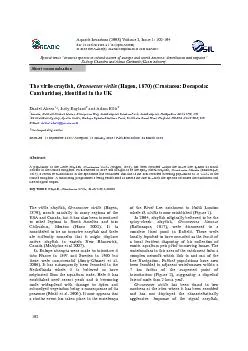/


Special issue ID: 213225
Download Pdf The PPT/PDF document "Aquatic Invasions (2008) Volume 3, Issue..." is the property of its rightful owner. Permission is granted to download and print the materials on this web site for personal, non-commercial use only, and to display it on your personal computer provided you do not modify the materials and that you retain all copyright notices contained in the materials. By downloading content from our website, you accept the terms of this agreement.
Aquatic Invasions (2008) Volume 3, Issue 1: 102-104 doi: 10.3391/ai.2008.3.1.18 (Open Access) © 2008 The Author(s). Journal compilation © 2008 REABIC Special issue Invasive species in inland waters of Europe and North America: distribution and impacts Sudeep Chandra and Almut Gerhardt (Guest Editors)102 Short communication identified in the UK 103 FigureA male virile crayfish, Orconectes virilis, collected from the Lee Navigation, North London in 2006 (Photo: DM Holdich). Note that the left cheliped is of a Form I sexually active individual, whereas the regenerating right cheliped is that of Form sexually inactive individual. It should also be noted that the colouring of this specimen, which had been frozen, is not the same as that of a fresh specimen. FigureThe current distribution of Orconectes virilis in the River Lee catchment, North London. The right hand map gives an overview of dispersal. The left hand map shows the source and its believed relationship to the watercourses where virilis is currently found. (Map: A. Ellis). Pacifastacus leniusculus (Dana, 1852), when handled. Initial inspection of the catch returns from trapping have shown carapace lengths, measured from the tip of the rostrum to the base of the carapace, ranging from 29 mm to 79 mm. The presence of O. virilis is a further threat to the UKs indigenous white-clawed crayfish, Austopotamobius pallipes (Lereboullet, 1858) (Holdich et al. 2004), as it is a potential vector of the crayfish plague, Aphanomyces astaciSchikora (Saprolegniales). As only the second known country of occurrence within Europe, it will be interesting to see which habitats this new resident occupies, if it burrows like O. limosusif it continues to spread, and how it will interact with the already cosmopolitan communities within this network of watercourses. The following invasive species, Chinese mitten crab, Eriocheir sinensis (H. Milne Edwards, 1854), topmouth gudgeon, Pseudorasbora parva(Temminck et Schlegel, 1846) and zebra mussel, Dreissena polymorpha (Pallas, 1771), are recorded from the same watercourses as Within the River Lee catchment two other species of alien crayfish are also present, leniusculus and narrow-clawed crayfish Astacus leptodactylus (Eschscholtz, 1823). D. Ahern et al. 104 An on-going monitoring programme is being established to assess the progress of O. viriliswithin the River Lee catchment. It is hoped that the detection of this species in an early stage of its establishment will lead to an unusual opportunity to record, as comprehensively as possible, the potential impacts of O. virilisThanks are due to David Holdich for confirming the identification and for making useful comments on the manuscript. ReferencesHoldich DM, Black J (2007) The spiny-cheek crayfish, Orconectes limosus (Rafinesque, 1817) [Crustacea: Decapoda: Cambaridae], digs into the UK. Invasions 2(1): 115, http://dx.doi.org/10.3391/ai.2007.2.1.1Hamr P (2002) Orconectes. In: Holdich DM (ed) Biology of freshwater crayfish. Blackwell Science, Oxford, pp 585-McAlpine DF, McAlpine AHE, Madden A (2007) Occurrence of the potentially invasive crayfish, Orconectes virilis(Decapoda, Cambaridae) in eastern New Brunswick, Canada. Crustaceana 80(4): 509511, http://dx.doi.org/ 10.1163/156854007780440939Pöckl M, Holdich DM, Pennerstorfer J (2006) Identifying native and alien crayfish species in Europe. European Project CRAYNET, 47 pp Souty-Grosset C, Holdich DM, Noël PY, Reynolds JD, Haffner P (eds) (2006) Atlas of Crayfish in Europe. Museum national dHistoire naturelle, Paris, 187 pp (patrimonies naturels, 64)Records of established populations of Orconectes virilis in England 2004-2007. Location Record coordinates First record date Collector Latitude, °N Longitude, °W Pond, London 51°40.13' 0°01.12' 2004 Environment Agency, UK Small R. Lee, London 51°40.26' 0°01.12' 2004 Environment Agency, UK Turkey Brook, London 51°40.02' 0°01.26' 2006 Environment Agency, UK Lee Navigation, London 51°37.32' 0°01.58' 2004 Environment Agency, UK Lee Navigation, London 51°36.01' 0°02.50' 2006 Environment Agency, UK Lee Navigation, London 51°38.22' 0°01.57' 2007 Environment Agency, UK